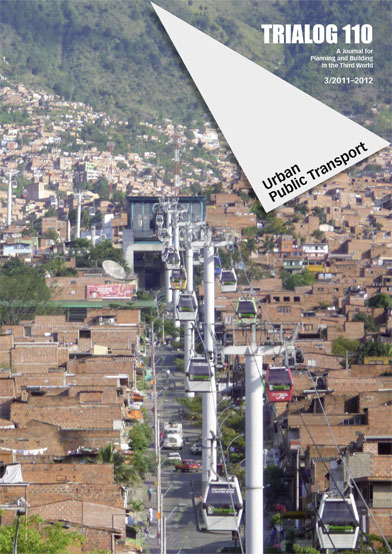Mobility in ever-growing urban areas is associated with several key urban development challenges, such as equal access to services and income opportunities. Urban Public Transport stretches, therefore, far beyond just transportation and traffic management and also includes such topics as an inclusive city for all residents, spatial segregation, land-use planning, and accessibility not only in technical terms but also in social terms.
This TRIALOG issue on Urban Public Transport examines projects in cities in Latin America, Africa and Asia, how they address mobility problems, and the lessons learned. In some cases, specifically in Jakarta and Bogotá, the contributions in this issue return to cases that were the focus of the TRIALOG issue on Urban Mobility from almost 10 years ago (TRIALOG No. 82). For these cases, the articles offer a deeper and longer-term analysis of the effects that followed implementation.
Anke Schwarz analyses the mobility pattern of the urban poor in Mexico City and discusses the impacts of immobility or limited mobility and social segregation based on case study settlements and individuals. She highlights the impact of restricted mobility on the livelihood of the residents.
The next set of articles addresses different aspects of public transport. Jean-Marc Mirailles explores the question of which criteria should be applied to select the most suitable technical solution for mass urban transport. Using Bogotá as example, he compares a metro system, a bus rapid transit system (BRT), a light rail system, and a tram-and-bus system. He highlights the problems in planning for mass urban transit that arise primarily from a lack of dialogue between technicians, urban planners and politicians and their diverging strategies. He discusses the advantages and disadvantages in transport planning between a BRT and metro in view of financial aspects (investments costs and operating costs), flexibility and capacity limits. Carolin Höhnke and Regina Witter both study the reorganisation of the public transport system Transantiago in Santiago de Chile. Carolin looks at the planning and implementation problems and opportunities in the development of the Transantiago with an emphasis on the role of the different actors and institutions involved. She concludes with lessons learnt for other cities. Regina analyses the Transantiago from the user perspective and analyses the situation before and after the introduction of the Transantiago. Her particular focus is on residents living in disadvantaged communities and the difficulties they face following the reorganisation.
The influence of a BRT system on urban traffic conditions is discussed by Sunghyun Jang, taking Jakarta, Indonesia, as a case. He focuses on the
changes in mode choice after the introduction of the TransJakarta system. He specifically examines the impacts on the mobility of the urban poor, who cannot all take advantages of the system, and how congestions on the road have remained due to the limited capacities of the system.
Lisa Reudenbach and Wolfgang Scholz study the mobility patterns and residential location of middle class households in Dar es Salaam, Tanzania. Increasing car ownership allows this growing group to build homes at the periphery, where land is available at lower prices, and to compromise the disadvantages of a longer commuting distance and time. The article uncovers the selection criteria of the middle class for their residential location and choice of transport mode, and provides implications for land-use and transport planning. Stefanie Holzwarth picks up the idea of a BRT and studies various BRT projects in Africa. From the different cities at different stages of BRT implementation, lessons can be learnt for the planning and implementation of new BRT systems in African cities.
The next two articles discuss other technical solutions that have moved into focus more recently: aerial cable cars and urban ropeways, which can provide accessibility to topographically restricted areas. Dirk Heinrichs and Judith S. Bernet look at the impact of introducing a cable car in Medellín, Colombia, where it is part of an integrated urban planning project designed to improve overall conditions in informally built neighbourhoods. They explore to what extent this ‘transport innovation’ modifies accessibility and inclusion into urban life and urban economy. Joachim Bergerhoff and Jürgen Perschon conclude this issue with an analysis of urban ropeways from a technical and financial perspective. The authors highlight their efficiency and their potential to complement metropolitan transport systems.
Overall, the collection of articles leads to the observation that a wide range of novel approaches is being used to improve access to mass transport in large and growing agglomerations around the world. At the same time, the articles illustrate the strong role that transport has in shaping the social and spatial conditions of cities.
Wolfgang Scholz, Dirk Heinrichs
Table of contents
- 04. Out All Day or Stay at Home: Mobility Patterns of the Urban Poor in Mexico City Anke Schwarz
- 08. Mass Transit Modes Relevance in Developing Countries. The Case of Bogotá Jean-Marc Mirailles
- 13. Potentials and Pitfalls of Transport Innovations: Lessons from Santiago de Chile Carolin Höhnke
- 17. Public Urban Transport, Mobility Patterns and Social Exclusion. The Case of Santiago de Chile Regina Witter
- 23. The Influence of a Bus Rapid Transit System on Urban Traffic Conditions. A Case Study of Jakarta Sunghyun Jang
- 27. Mobility and Residential Location of the Middle Class in Dar es Salaam Lisa Reudenbach, Wolfgang Scholz
- 32. Bus Rapid Transit Systems for African Cities Stefanie Holzwarth
- 38. Public Transport, Informal Settlements and Accessibility: The Case of Aerial Cable Cars in Medellín, Colombia Dirk Heinrichs, Judith S. Bernet
- 44. Urban Ropeways as Part of Sustainable Urban Transport Networks in Developing Countries Joachim Bergerhoff, Jürgen Perschon
- 50. Book Reviews / Neue Bücher
- 52. Forthcoming Events / Veranstaltungen

